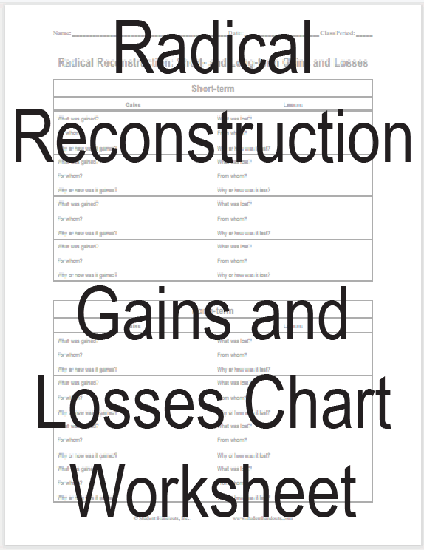Radical Reconstruction, which took place in the American South from 1867 to 1877, had both short-term gains and losses, as well as long-term consequences. This period followed the American Civil War and aimed to address the challenges of reintegrating the Southern states into the Union, protecting the rights of newly freed African Americans, and reshaping the political and social landscape of the South.
Short-Term Gains:
- Civil Rights Legislation: Radical Reconstruction led to the passage of significant civil rights legislation, including the Civil Rights Act of 1866 and the 14th Amendment to the U.S. Constitution. These laws aimed to grant citizenship and equal protection under the law to African Americans, laying the foundation for their legal rights.
- Voting Rights: Reconstruction governments in Southern states, often led by Republicans, extended voting rights to African American men. This led to a brief period of significant political empowerment for African Americans, including the election of African American legislators and officials.
- Public Education: Reconstruction governments established public education systems in the South, including schools for African American children. This marked a significant step toward providing education opportunities to a population that had been systematically denied access to learning.
- Land Redistribution: Some efforts were made to redistribute land to formerly enslaved individuals. Programs sought to provide land and resources to African American families, although these initiatives were often short-lived.
- Reconstruction Acts: The Reconstruction Acts of 1867 divided the South into military districts and required states to draft new constitutions that included African American voting rights and equal protection under the law.
Short-Term Losses:
- Resistance and Violence: Resistance to Reconstruction policies was widespread in the South, leading to violence and the rise of white supremacist groups such as the Ku Klux Klan. African Americans and sympathetic white Republicans faced intimidation and physical harm.
- Economic Disruption: The South's economy was severely disrupted by the Civil War, and Reconstruction efforts to reform the economic system and promote social equality faced resistance from white landowners and the broader white population.
Long-Term Consequences:
- End of Reconstruction: Reconstruction came to an end with the compromise of 1877, which marked the withdrawal of federal troops from the South and effectively ended efforts to enforce civil rights and voting rights for African Americans in the region.
- Rise of Jim Crow Laws: The end of Reconstruction ushered in the era of Jim Crow laws, which enforced racial segregation, disenfranchised African Americans, and established a system of legal discrimination that lasted for decades.
- Persistent Racial Inequality: The legacy of Reconstruction included persistent racial inequality in the South, as African Americans were denied access to education, economic opportunities, and political power for much of the 20th century.
- Civil Rights Movement: The struggles and achievements of Radical Reconstruction laid the groundwork for the Civil Rights Movement of the mid-20th century. The legal and political gains of Reconstruction served as a source of inspiration and legal precedent for the fight for civil rights and equality.
In summary, Radical Reconstruction brought about significant short-term gains in terms of civil rights and political empowerment for African Americans but faced resistance and ultimately led to long-term losses as the South reverted to segregation and racial discrimination. It set the stage for a prolonged struggle for civil rights and equality in the United States.
|











